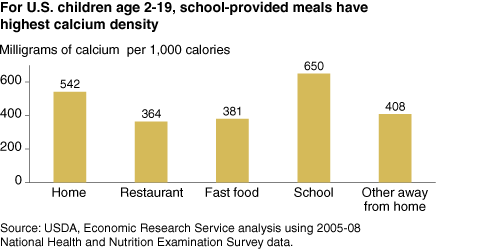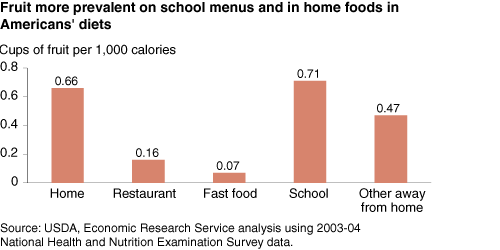Food and Nutrient Intake Data: Taking a Look at the Nutritional Quality of Foods Eaten at Home and Away From Home
- by Biing-Hwan Lin and Rosanna Mentzer Morrison
- 6/5/2012
The National Health and Nutrition Examination Survey (NHANES), conducted by USDA and the U.S. Department of Health and Human Services, provides information on what Americans are eating and how their food choices might be affecting their health. The 5,000 individuals who participate in the survey each year are asked to recall what they ate in the previous 24 hours for 2 separate, nonconsecutive days.
Survey respondents also report where foods were purchased and where they were eaten. Foods prepared in restaurants, school cafeterias, and other away-from-home eating places accounted for 42 percent of American households' food budgets and 32 percent of calorie intake during 2005-08. How the nutritional quality of these foods differs from that of foods eaten at home is one of the critical factors affecting the quality of Americans' diets.
Intakes of over 7,000 foods reported by NHANES respondents were converted into nutrient intakes using USDA's nutrient database. ERS researchers examined nutrient intake data to compare nutritional quality of foods by source--home versus away-from-home locations--focusing on eight nutrients that tend to be over- or under-consumed. Averages were calculated for the total U.S. population, children age 2-19, and adults age 20 and older.
Calorie Intake Rose Over Time, Especially From Outside the Home
ERS calculations reveal that Americans age 2 and older ate an average of 2,067 calories a day during 2005-08, up from 1,875 calories a day during 1977-78. This increase in calorie intake is consistent with rising obesity rates in the United States. During 2005-08, adults consumed 69 percent of their daily calories (1,454 calories) at home. At-home foods are obtained at supermarkets, grocery stores, convenience stores, and other retail outlets. Fast food places (264 calories), restaurants with waiter service (209 calories), and other commercial and nonprofit away-from-home sources (180 calories) accounted for the other daily calories consumed by adults.
Children age 2 to 19 obtained 67 percent of their daily calories (1,310 calories) at home. The remaining 33 percent came from fast food places (266 calories), restaurants (100 calories), school (140 calories), and other away-from-home sources (135 calories).
Nutrient Densities Vary by Food Sources
To compare nutritional quality of food by source, ERS researchers expressed nutrient intakes in terms of density--the amount of nutrients per 1,000 calories. Compared with home foods, away-from-home foods are more dense in over-consumed nutrients--total fat, saturated fat, sodium, and cholesterol--but contain less under-consumed nutrients--calcium, fiber, and iron.
For the total population, total fat and saturated fat accounted for 32.0 and 10.9 percent, respectively, of daily calories consumed at home and 38.7 and 12.6 percent, respectively, of calories consumed outside the home. Foods from home, on the other hand, contain more fiber and iron per 1,000 calories than away-from-home foods.
For children, school foods contain less total fat and cholesterol than foods from restaurants and fast food places but more saturated fat than restaurant foods. Because milk is a staple in school-provided breakfasts and lunches, school foods are richer in calcium (650 mg per 1,000 calories) than foods from any other source, both home and away from home. School foods also are denser in fiber content than foods from all other sources.
Food Away From Home Low in Fruit and Whole Grains, But Food at Home Higher in Added Sugars
ERS also looked at food groups consumed at home and away from home. Researchers used USDA's MyPyramid Equivalents Database to convert foods reported in NHANES into food group components. For example, a slice of apple pie was converted into cups of fruit, ounces of grain, teaspoons of solid fat, and teaspoons of added sugar. Based on a comparison with daily recommended intakes, the analysis found that Americans under-consumed fruit, vegetables, whole grains, and dairy but overconsumed added sugars and discretionary/added fats and oils.
Compared with away-from-home foods, home foods included more fruit (0.66 vs. 0.25 cup per 1,000 calories), dairy (0.89 vs. 0.67 cup), and whole grains (0.43 vs. 0.09 ounces) but less vegetables (0.70 vs. 0.94 cup). Tomatoes and potatoes accounted for almost half of total vegetable consumption (0.77 out of 1.63 cups per day), and dark-green and orange-color vegetables were lacking from all sources. For each 1,000-calorie intake, home foods contained 10 teaspoons of added sugars and 27 grams of fats and oils, compared with 8 teaspoons of added sugars and 34 grams of fats and oils for away-from-home foods.
This article is drawn from:
- Food Consumption, Nutrient Intakes, and Diet Quality. (n.d.). U.S. Department of Agriculture, Economic Research Service.
We’d welcome your feedback!
Would you be willing to answer a few quick questions about your experience?





